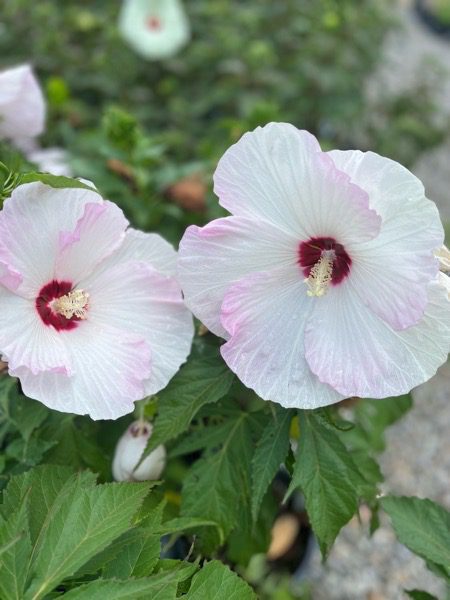Hibiscus, Ballet Slippers
Price range: $14.99 through $89.99
Plant, Zone 4+
Discount per quantity
| Quantity | 3 - 8 | 9 - 14 | 15+ |
|---|---|---|---|
| Price | Price range: $14.54 through $87.29 | Price range: $14.09 through $84.59 | Price range: $13.49 through $80.99 |
| % Discount | 3% | 6% | 10% |
Description
Hibiscus ‘Ballet Slippers’: Soft Elegance in Motion
Hibiscus ‘Ballet Slippers’ lives up to its graceful name. Its blooms unfurl like delicate tutus, blending pure white petals with soft pink edges and a glowing red center. Unlike many hibiscus varieties that make a bold, tropical statement, Ballet Slippers feels refined and airy — perfect for gardeners who want something eye-catching but elegant.
This guide dives deep into everything about this hardy hibiscus. We’ll explore its appearance, growth habits, care needs, design ideas, and why it remains a favorite for pollinator-friendly gardens. By the end, you’ll see why this plant is a must-have for those who love summer blooms that feel timeless and fresh.
A Flower That Dances in the Sun
The name “Ballet Slippers” captures the essence of this hibiscus. Each bloom measures eight to nine inches wide and features white petals edged with soft blush-pink. A deep red eye sits at the center, drawing pollinators straight to the nectar.
The color combination is soothing yet dynamic. As flowers mature, the pink edging deepens, creating subtle variations across the plant. In full bloom, it resembles a stage filled with delicate, swirling skirts — a living performance in your garden.
Growth Habit and Plant Structure
Ballet Slippers forms a compact, rounded mound that typically reaches about three feet tall and spreads up to four feet wide. Its foliage is medium green, providing a clean backdrop for the soft, romantic blooms.
Like other hardy hibiscus varieties, it emerges late in spring. Gardeners often think it’s gone for good, but patience pays off. Once warm weather arrives, it grows quickly, producing abundant buds by midsummer.
Best Location for Planting
Ballet Slippers thrives in sunny spots. Aim for at least six hours of direct sunlight each day. More sun means more blooms and richer color.
The soil should be fertile, moist, and well-drained. Hardy hibiscus love water but dislike soggy roots. If your soil is heavy clay, amend it with compost or plant in raised beds. Good airflow also prevents mildew, keeping leaves fresh and healthy through the season.
Planting Guide for Success
- Choose the season – Late spring or early summer is ideal, after all frost danger has passed.
- Prepare the soil – Loosen the ground and enrich it with compost or organic matter.
- Dig a wide hole – Twice as wide as the root ball, but no deeper.
- Set the plant – Place the root ball level with the surrounding soil.
- Backfill and water – Firm the soil gently and water thoroughly to help roots settle.
- Mulch generously – A layer of mulch conserves moisture and keeps weeds away.
Watering and Feeding Needs
Ballet Slippers appreciates consistent moisture, especially in the heat of summer. Deep waterings two to three times per week are ideal. Avoid letting the soil dry out completely, as this can cause buds to drop.
Fertilize in spring when new shoots appear. A balanced fertilizer or one slightly higher in potassium encourages lush blooms. Reapply every four to six weeks through summer for maximum flowering. Stop feeding in early fall so the plant can prepare for dormancy.
Pruning and Ongoing Care
Hardy hibiscus like Ballet Slippers are low-maintenance. Prune back old stems to about six inches above ground in late fall or early spring. This clears space for new growth each season.
Deadheading is optional. Each bloom lasts just a day or two, but the plant produces flowers continuously. Removing spent blooms keeps the plant looking tidy but doesn’t affect blooming performance.
Winter Hardiness
Ballet Slippers is hardy in USDA zones 4–9, making it suitable for most gardens. After frost, the plant dies back to the ground. Add a thick layer of mulch around the root zone to protect it during cold months.
Don’t panic if it’s slow to reappear in spring — hardy hibiscus are often the last perennials to emerge. Once temperatures warm, it will quickly catch up and burst into growth.
Comparing Ballet Slippers to Other Hardy Hibiscus
Ballet Slippers offers a softer look than many hardy hibiscus varieties. Its white and blush tones contrast with bold reds like ‘Midnight Marvel’ or yellow varieties like ‘French Vanilla.’ Compared to ‘Spinderella,’ Ballet Slippers is slightly more compact and has a more uniform pink edge.
If you want a hibiscus that feels romantic and blends easily into pastel or cottage-style gardens, Ballet Slippers is ideal.
Pollinator Appeal
The open flowers are magnets for bees, butterflies, and hummingbirds. The red center acts as a natural nectar guide, leading pollinators right to the reward. By planting Ballet Slippers, you not only add beauty but also support local wildlife.
Companion Planting Ideas
Pair Ballet Slippers with plants that complement its soft colors and bold blooms:
- Lavender or Russian sage – Their silvery foliage and purple flowers create beautiful contrast.
- Daylilies and coneflowers – These extend the color palette and share similar care needs.
- Ornamental grasses – Their texture balances the large hibiscus flowers.
- Dark foliage shrubs – Such as ninebark or barberry, which make pale blooms pop.
Use Ballet Slippers as a centerpiece in mixed borders, plant in groups for dramatic impact, or feature in large containers for patios and decks.
Container Growing Tips
Ballet Slippers thrives in large pots, provided you meet its moisture needs. Choose containers at least 18–20 inches wide and deep. Use high-quality potting mix with good drainage. Because pots dry out faster, water more frequently in hot weather.
Feed regularly with a balanced liquid fertilizer every two to three weeks during the growing season. In cold zones, move containers to a sheltered location or insulate them for winter.
Common Pests and Problems
Hardy hibiscus are generally resilient, but you may encounter:
- Aphids – Can cluster on new growth; spray with water or use insecticidal soap.
- Japanese beetles – May chew flowers and leaves; handpick or use nearby traps.
- Leaf spot or mildew – Can occur in humid weather; ensure good spacing and avoid overhead watering.
These issues are usually minor and easy to manage with prompt attention.
Propagation Methods
You can propagate Ballet Slippers by division or cuttings. In spring, divide mature clumps by digging up the root mass and separating it into sections. Replant divisions right away. For cuttings, take softwood cuttings in early summer and root them in moist soil or water.
Propagation is an excellent way to expand your garden or share plants with friends and family.
Seasonal Highlights
- Spring – Slow to emerge but worth the wait; fresh green leaves appear.
- Summer – Full bloom season; white and blush flowers cover the plant.
- Fall – Continued flowering until frost; foliage provides lush texture.
- Winter – Dormant period; mulch protects roots until spring return.
Why Gardeners Love Ballet Slippers
Gardeners are drawn to Ballet Slippers for its romantic charm and steady performance. It offers massive flowers but with a softness that fits seamlessly into many garden styles. Its compact size makes it suitable for small spaces, while its bloom power makes it a standout in larger landscapes.
Beyond beauty, it’s dependable. Once established, it returns each year stronger and fuller, requiring minimal care. It also supports pollinators, adding ecological value to its ornamental appeal.
Perfect for Every Garden Style
Ballet Slippers works equally well in cottage gardens, modern landscapes, and pollinator-friendly spaces. In formal gardens, it provides structure and color. In wildflower meadows, it adds a touch of refinement. Wherever you plant it, Ballet Slippers brings softness and movement — a gentle counterpoint to bolder summer blooms.
A Plant That Feels Like Poetry
There’s something soothing about Ballet Slippers. Its blooms open wide on warm summer mornings, soft pink edges glowing in the sun. Bees hum around it. Butterflies linger. Even from a distance, the plant invites you closer.
Graceful Color for Endless Summers
Planting Hibiscus ‘Ballet Slippers’ is like adding a touch of elegance to your outdoor space. It transforms sunny borders, brightens patios, and charms pollinators all season long. With its easy care and reliable blooms, it’s a plant you’ll treasure year after year.
When summer arrives and those first blossoms open, you’ll know why it’s called Ballet Slippers. Soft, graceful, and unforgettable — it’s a flower that turns any garden into a stage.
Additional information
| Weight | N/A |
|---|---|
| Options | 4 in. (16.9 fl. oz.) Pot, 1 Gallon Pot, 3 Gallon Pot |





